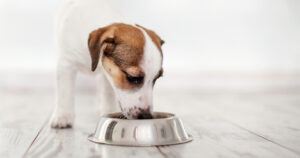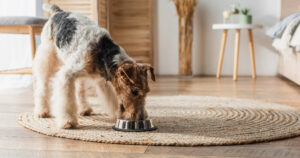Artificial grass has become an increasingly popular alternative to natural grass lawns, especially for dog owners. With its low maintenance requirements, year-round green color, and durability, it offers many benefits.

However, there are also some downsides to consider before installing artificial turf in your backyard. Weighing the pros and cons can help determine if switching to an artificial lawn is right for you and your furry friend.
Pros of Artificial Grass for Dogs
Less Maintenance
One of the biggest advantages of artificial grass is the reduction in maintenance compared to a traditional lawn. There’s no more mowing, watering, fertilizing, aerating, or reseeding required. The synthetic blades retain their fresh, green appearance regardless of weather or season. This makes caring for an artificial lawn much simpler and less time-consuming than a natural grass one.
Withstands Wear and Tear
Dogs love to dig, run, play, and roll around in the grass. These activities can quickly damage and deteriorate a natural lawn. However, artificial grass is specifically designed to withstand pet activity. Its durable construction can resist digging, tearing, urine scorching, and heavy traffic from animals. This allows dogs to play while preserving your lawn’s appearance.
Cleaner Environment
Muddy paws are a common problem for dog owners with grass lawns. Synthetic turf prevents this issue by not producing mud or retaining moisture. Dogs can play outside without tracking in dirt or soiling your home. Artificial grass also deters pests like fleas and ticks due to its lack of moisture and organic matter. This creates a cleaner outdoor space for pets.
Allergy Friendly
Many dogs suffer from grass or pollen allergies that cause skin irritation, coughing, sneezing, and other symptoms. Artificial lawns are constructed from synthetic materials that won’t trigger environmental allergies. This allows dogs with sensitivities to enjoy playing in the yard without allergic reactions. It also prevents pollen from being tracked indoors.
Consistent Appearance
Natural grass grows in cycles and its appearance varies by season. It can become patchy, discolored from urine spots, suffer pest damage, and die out in extreme weather. Synthetic grass maintains its vibrant, uniform color and texture year-round. Your lawn will look freshly manicured every day regardless of the amount of use it receives.
Water Conservation
A sizable grass lawn requires significant amounts of water, which increases your utility bills. Synthetic grass needs no irrigation, fertilizer, or other lawn treatments that rely on water usage. This saves thousands of gallons over the lifetime of your artificial lawn. Converting to artificial turf supports water conservation efforts.
Cons of Artificial Grass for Dogs
Higher Upfront Cost
The main disadvantage of artificial grass is its higher initial price point. Installation costs roughly two to three times more than laying new sod. For a basic installation in a small yard, you may spend around $5 per square foot. Larger lawns or those with landscape features can cost $8-$12 per square foot. The investment may pay off long-term, but it represents a greater upfront expense.
Lifespan Requires Replacement
While artificial grass is very durable, it does deteriorate over time. Expect to get around 10 years of life from a properly installed synthetic lawn before needing replacement. The cost of removing and replacing the turf represents an added expense not associated with natural grass. However, replenishing a distressed sod lawn can also require significant time and money.
Limited Recyclability
Most types of artificial grass are not readily recyclable. At the end of its lifespan, the used turf often ends up in landfills. There are a limited number of specialty recycling programs available, but accessibility is sparse. The lack of recyclability leads to questions about the sustainability of synthetic turf over time. However, companies are developing alternative materials and processing methods to improve recyclability.
Can Get Too Hot
Unlike grass, artificial lawns are constructed from synthetic materials that absorb and retain heat. On hot, sunny days the surface temperature of the blades and infill can reach extreme highs. This poses a safety risk, especially for pets with sensitive paw pads. Providing shade, adequate water, avoiding mid-day use, and selecting turf with cooling technology are important considerations.
Odor Control
Dog urine and waste can create potent odors if allowed to seep beneath the turf backing. Artificial grass requires observant waste removal and routine cleaning to prevent buildup of smells. Diligent maintenance and proper drainage will keep odors at bay. But negligence can lead to persistent foul smells that are difficult to remedy.
Off-Gassing Potential
There are concerns around potentially toxic off-gassing from some artificial grass products. Lower quality turf produced with inferior materials could off-gas chemicals and VOCs during hot weather. Reputable manufacturers use non-toxic materials and construction methods to minimize this risk. But it remains a point of concern for dogs and children playing on the lawn.
Environmental Impact
Critics argue that the plastics and materials used to produce artificial turf are environmentally unfriendly. It prevents natural biological processes, interrupts the soil ecosystem, and can release microplastics. Supporters note the water conservation benefits and limited fertilizer use counteract these detriments. Overall, the eco-impact needs further research.
Key Takeaway: Artificial grass requires less maintenance, retains its appearance, and withstands pets better than natural lawns. But the higher upfront cost, replacement needs, heat absorption, odor potential, and eco-impact are downsides to consider.
Is Artificial Grass Safe for Dogs?
A common concern among pet owners considering artificial turf is whether it poses any risks or toxicity dangers to dogs. There were instances in the past of toxic materials like lead being used in manufacturing. However, today’s high-quality artificial grass products are completely non-toxic and pet safe.
When sourced from reputable suppliers, artificial grass fibers and infill materials meet stringent standards for heavy metal content and hazardous substance testing. Routine third-party testing helps ensure modern turf contains no lead, zinc, mercury, or other toxic metals.
Drainage and Off-Gassing
Proper drainage and ventilation are vital for a dog-friendly artificial lawn installation. The backing and base materials must allow for drainage to prevent urine puddling. And airflow circulation under the turf minimizes any off-gassing issues.
Abrasion Resistance
Look for turf fibers with UV-inhibitors and colorfastness built in. This prevents fading and breakdown that could increase abrasiveness under paws. Turf with adequate fiber thickness and dense stitching resists matting, rolling, and tearing for enhanced pet safety.
Temperature Management
Select turf made from materials designed to diffract sunlight and reduce heat absorption. Opt for shorter blade lengths to minimize heat buildup as well. Incorporating infrared-reflective pigments into the grass coloration also helps maintain lower temperatures compared to traditional dark or light green hues.
Key Takeaway: Modern artificial grass is non-toxic and safe when proper installation methods are followed. But temperature control, drainage, and abrasion resistance require attention.
How to Care for Artificial Grass With Pets
Caring for an artificial lawn with dogs takes some adjustments compared to a natural grass one. But it is relatively simple with proper planning and a routine care regimen. Here are some top tips for keeping your synthetic turf clean, sanitized, and odor-free.
Prompt Waste Removal
Immediately picking up solid pet waste prevents staining and odors. Any urine should be flushed thoroughly with water and a mild detergent to stop it seeping beneath the backing. Urine enzymes and deodorizers can also be applied weekly.
Rinsing
Use a garden hose to rinse down the entire lawn at least once per week. This removes dirt, debris, and dust that accumulates. Adjust water pressure to avoid damaging the blades while still lifting soils.
Deodorizing
Specialty turf deodorizers help eliminate odors and control ammonia buildup from urine. Look for non-toxic enzyme digesters suitable for pets. For spot treatment, a 50/50 vinegar and water solution can disinfect problem areas.
Grooming
Use a stiff brush or broom weekly to fluff up matted blades and redistribute infill material displaced by activity. Removing flattened spots maintains texture and comfort under paw.
Weed Control
Weeds can sprout around the edges and permeable backing. Carefully apply pet-safe herbicides around the perimeter monthly. For small weeds, non-toxic household alternatives like boiling water or vinegar work well.
Deep Cleaning
Every 3-4 months use a wet/dry vacuum on the grass to lift out debris lodged in the blades. Then rinse thoroughly with an enzymatic cleaner and deodorizer compatible with pets. Allow the turf to dry completely before letting your dog back onto the lawn.
Key Takeaway: Proper artificial grass care with dogs requires diligent waste removal, routine grooming and deodorizing, weed control, and periodic deep cleaning.
What to Look for in Dog-Friendly Artificial Grass
When selecting artificial turf for dogs, look for products designed specifically to withstand pets. Some features and qualities to seek out include:
- Permeable backing: Allows liquid to drain through rather than pooling on the surface. Enhanced drainage prevents odors and bacteria.
- Antimicrobial treatments: Inhibits mold, mildew, and odor-causing microbes from taking hold in the turf fibers.
- Pet-friendly infill: Silica sand or zeolite infills resist retaining urine smells compared to crumb rubber.
- Dense, texturized blades: Prevents matting and resists abrasion damage from paws. Improved durability and longevity.
- Low-profile blades: Pile height around 1″-1.5″ makes cleaning pet waste simpler. Longer fibers trap more debris and allergens.
- UV stabilization: Protects against fading, deterioration, and increased brittleness over time through sun exposure. Improves lifespan.
- Woven backing: Provides multidirectional durability against digging, tearing, and high-traffic environments.
- Warranty: Seek at least an 8-10 year manufacturer warranty for durability assurance.
Artificial Grass vs. Natural Grass for Dogs
Determining whether to choose artificial turf or stick with a traditional lawn depends on your priorities. Here is a side-by-side comparison of some factors:
| Artificial Grass | Natural Grass | |
|---|---|---|
| Maintenance | Very low | High |
| Appearance | Uniform green, immaculate | Seasonal variations, imperfections |
| Durability | Highly durable | Susceptible to damage |
| Safety | Non-toxic, consistent texture | Can harbor pests, molds, fertilizer risks |
| Cost | Higher initial cost, lower long-term | Lower initial cost, ongoing maintenance |
| Water Use | None required | High water demand |
| Comfort | Can get overly hot, dewless | Softer, cooler, retains moisture |
Ultimately, the choice comes down to your climate, lawn usage, maintenance preferences, and budget. Natural grass provides a lush, authentic experience but requires more work. Artificial turf simplifies upkeep with comparable aesthetics, but has temperature and environmental drawbacks.
FAQs
Does artificial grass smell with dogs?
It can if waste is not cleaned promptly. But proper drainage, antimicrobial treatments, and routine cleaning prevents lingering odors. Avoid infill materials like crumb rubber that absorb odors.
How do you clean dog urine from artificial grass?
Flush the area immediately to prevent seepage, removing any solids first. Mix a mild detergent and water solution to lift residue from blades. Rinse thoroughly and allow to fully dry in sunlight.
Does artificial turf get too hot for dogs?
It can, reaching up to 20°F hotter than ambient temperatures. Look for IR-reflective grass, cooling infill, and blade heights under 2″. Provide shade and avoid peak sun hours.
Can dogs chew up artificial grass?
High-quality turf is quite durable, but aggressive chewers could potentially damage blades or backing. Opt for a denser knitted backing and pile density exceeding 60 ounces to resist chewing damage.
Is artificial grass safe for senior dogs?
Yes, provided it has a dense, supportive thatch layer for improved comfort. Avoid abrasive fibers and ensure adequate drainage and cleaning to prevent slipping. Never use crumb rubber infill, which can aggravate joint issues.
Conclusion
Artificial grass offers dog owners clear benefits when it comes to maintenance, durability, water savings, and pest resistance. However, drawbacks like costs, heat absorption, odors, and eco-impact require consideration.
Pet-friendly artificial turf continues to improve through material innovations like built-in antimicrobials and reflective pigments. Proper installation and care are key to maximizing the pros while minimizing the cons.







